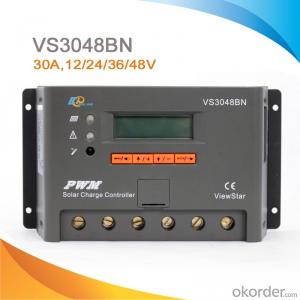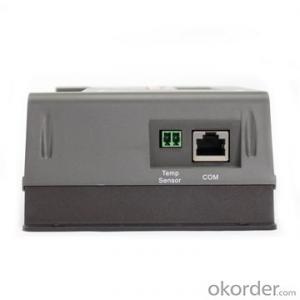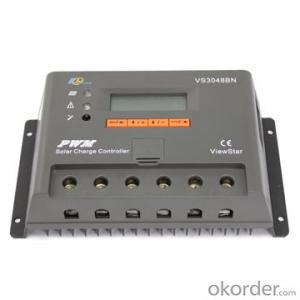LCD Display PWM Solar System Charge Controller /Regulator 30A 12/24/36/48V,VS3048BN
- Loading Port:
- Tianjin
- Payment Terms:
- TT or LC
- Min Order Qty:
- -
- Supply Capability:
- 10000 pc/month
OKorder Service Pledge
OKorder Financial Service
You Might Also Like
ViewStar series solar controller is our new generation controller for off-grid solar system, such as street light, solar home system or small power station etc.
Features:
·Excellent EMC design
·32 bit MCU with high speed
·High efficient Series PWM charging
·Four battery type options: Sealed, Gel, Flooded, and USER
·Intelligent lighting and timer control for solar lighting system
·12 bit A/D high-precision sampling to ensure accuracy
·Use MOSFET as electronic switch
·Full control parameters setting and modification, diversified load control mode
·Humanized design of browser interface, undertake every operating conveniently
·Temperature compensation
·Adopt graphics dot-matrix LCD screen and HMI (human-machine interface) with 4 buttons,integrated menu displaying and operation
·Energy statistics function
·RS485 ports with MODBUS communication protocol
·Optional PC monitoring software and remote meter for real-time monitoring and battery management parameter setting
·Field upgradable firmware
Electronic Protections:
·PV short circuit protection
·PV reverse polarity protection
·Battery overcharge protection
·Battery over discharge protection
·Battery reverse polarity protection
·Load overload protection
·Load short circuit protection
·Overheating protection
Specification:
Nominal system voltage | 12/24/36/48V auto work | |||
Rated battery current | 20A | 30A | 45A | 60A |
Rated load current | 20A | 30A | 45A | 60A |
Max. battery voltage | 64V | |||
Equalize charging voltage | Sealed: 14.6V, Flooded: 14.8V, User-defined: 9~17V | |||
Boost charging voltage | Gel: 14.2V, Sealed: 14.6V, Flooded: 14.8V, User-defined: 9~17V | |||
Float charging voltage | Gel /Sealed /Flooded: 13.8V, User-defined: 9~17V | |||
Low voltage reconnect voltage | Gel /Sealed /Flooded: 12.6V, User-defined: 9~17V | |||
Low voltage disconnect voltage | Gel /Sealed /Flooded: 11.1V, User-defined: 9~17V | |||
Self-consumption | ≤15mA(12V); ≤10mA(24V); ≤9mA(36V); ≤8mA(48V) | |||
Grounding | Common negative | |||
Temp. compensation | -3mV/°C/2V | |||
Relative humidity | 10%~90% Non-condensation | |||
Communication | RS485 / RJ45 interface | |||
LCD temperature | -20°C ~ +70°C | |||
Working temperature | -25°C ~ +55°C | |||
Humidity | ≤95% N.C. | |||
Enclosure | IP30 | |||
Overall dimension | 200x103x58mm | 201x109x59mm | 205x119x67mm | 205x174x64mm |
Terminals | 16mm2 | 35mm2 | 35mm2 | 35mm2 |
Net weight | 0.7kg | 0.9kg | 1.2kg | 1.5kg |
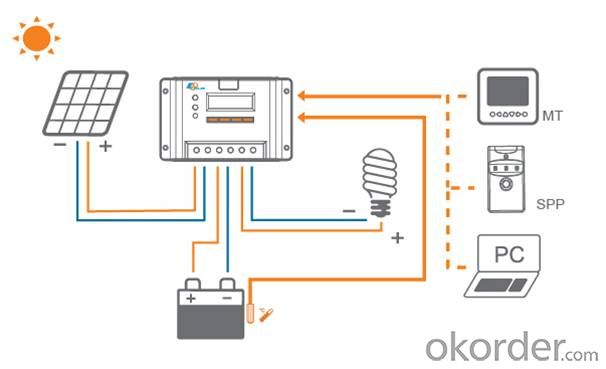
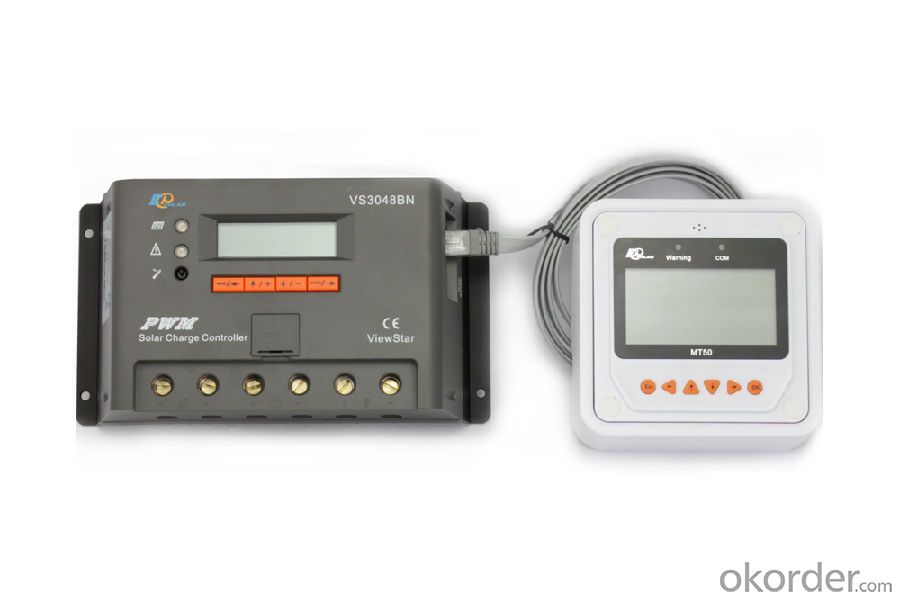

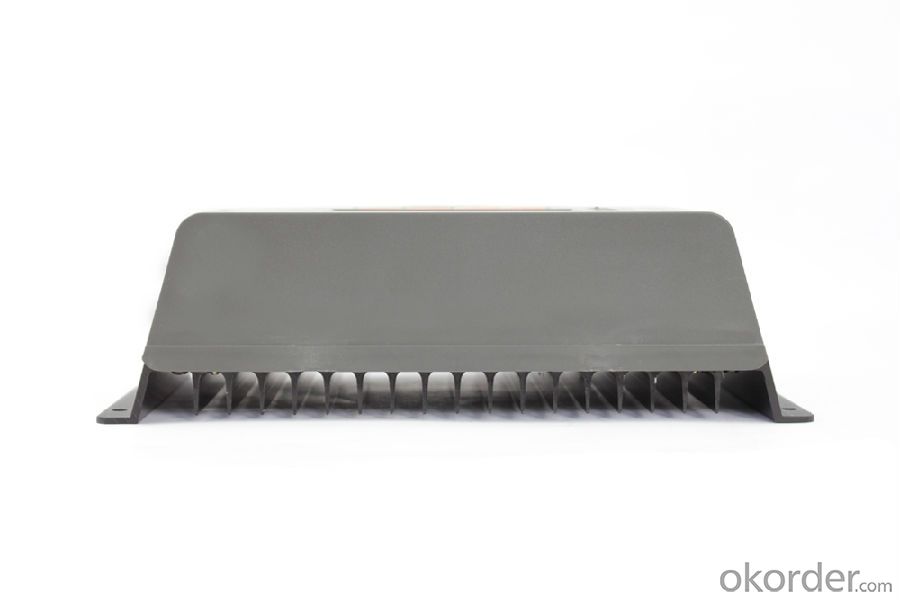
FAQ:
Q1. What is the voltage?
A1. Our 45/60A solar charge controller is 12/24/36/48V auto work.
Q2. What is the difference between MPPT&PWM?
A2. MPPT has higher efficiency, it can track the max power point and won't waste energy.
Q3. What is the efficiency of the MPPT controller?
A3. MPPT>99%, peak conversion efficiency>98%.
Q4. What is the waranty of product?
A4. 12 months.
- Q:What are the advantages of using a solar controller in a solar power system?
- The advantages of using a solar controller in a solar power system are numerous. Firstly, it helps regulate the charging process of the battery, ensuring optimal charging and preventing overcharging or deep discharging. This extends the lifespan of the battery and improves its overall performance. Additionally, a solar controller provides protection to the solar panels by preventing reverse current flow during nighttime or low light conditions. This safeguards the panels from potential damage and maximizes their efficiency. Moreover, a solar controller typically features built-in temperature compensation, which adjusts the charging voltage according to the temperature. This compensates for fluctuations in temperature and ensures consistent and efficient charging of the battery. Furthermore, many modern solar controllers come with advanced features such as LED displays, programmable settings, and data logging capabilities. These features enable users to monitor and optimize the performance of their solar power system, making it more user-friendly and efficient. Overall, using a solar controller in a solar power system offers advantages such as battery protection, increased efficiency, temperature compensation, and enhanced system monitoring capabilities.
- Q:Can a solar controller be used with a solar-powered marine navigation system?
- A solar-powered marine navigation system can utilize a solar controller. This crucial component, also known as a charge controller, is integral to a solar power system. It regulates the flow of electricity from the solar panels to the battery bank, ensuring optimal charging and preventing battery damage or overcharging. In the context of a solar-powered marine navigation system, the solar controller plays a vital role in managing the energy produced by the solar panels. Its primary function is to efficiently charge the batteries and protect them from overcharging, which can lead to reduced battery lifespan or failure. With the use of a solar controller, the solar-powered marine navigation system can effectively harness solar energy and convert it into usable power for the navigation equipment. This capability enables the system to operate reliably and sustainably, even in remote or off-grid locations where traditional power sources may be scarce or inaccessible. Hence, a solar controller is not only compatible but also indispensable for the proper functionality and durability of a solar-powered marine navigation system.
- Q:How do I connect solar panels to a solar controller?
- Follow these steps to connect your solar panels to a solar controller: 1. Begin by positioning your solar panels in a location that receives maximum sunlight throughout the day. Make sure they are securely mounted and properly angled for optimal sun exposure. 2. Locate the positive and negative terminals on your solar panels, which are typically labeled as "+" and "-". Consult the user manual or markings on the panels for accurate identification. 3. Once you have found the terminals, make the connections. Attach the positive terminal of the first solar panel to the positive input terminal of the solar controller using a solar panel cable or wire with appropriate connectors. Repeat this step for the negative terminals, connecting the negative terminal of the first solar panel to the negative input terminal of the solar controller. 4. If you have multiple solar panels, follow the solar controller's specifications and your energy requirements to determine whether to connect them in series or parallel. In series connections, link the positive terminal of one panel to the negative terminal of the next panel. In parallel connections, connect all positive terminals together and all negative terminals together. 5. Double-check all the connections to ensure they are secure. Loose connections can result in power loss and inefficiency. 6. Finally, connect the solar controller to your battery bank or power inverter. Most solar controllers have separate terminals for battery connections, labeled as "+" and "-". Connect the positive terminal of the battery to the positive output terminal of the solar controller, and the negative terminal of the battery to the negative output terminal of the solar controller. 7. After completing the connections, power on the solar controller and monitor the charging status. The solar controller will regulate the power flow from the solar panels to the battery bank, ensuring efficient charging and preventing overcharging. Always refer to the user manual provided with your specific solar panels and solar controller for any manufacturer-specific instructions or guidelines.
- Q:Can a solar controller be used with a solar-powered irrigation pump?
- Yes, a solar controller can be used with a solar-powered irrigation pump. The solar controller helps regulate and optimize the energy from the solar panels, ensuring proper power management and efficient operation of the pump.
- Q:What is the maximum charging time a solar controller can handle?
- The maximum charging time a solar controller can handle depends on the specific model and its capabilities. Typically, solar controllers can handle charging for extended periods, ranging from several hours to even days, depending on the capacity and design of the controller.
- Q:Are there any safety features built into solar controllers?
- Solar controllers come with multiple safety features. One of the primary safety features is overcharge protection. The purpose of solar controllers is to prevent batteries from getting overcharged, which can result in damage or even explosions. The controller constantly monitors the battery voltage and adjusts the charging current to ensure optimal charging without any risk of overcharging. Another safety feature is reverse polarity protection. This particular feature safeguards the solar controller from any potential damage caused by accidentally reversing the battery or solar panel connections. It effectively prevents short-circuits or harm to the controller. Furthermore, many solar controllers incorporate over-discharge protection. This feature prevents excessive discharge of the battery, which can lead to reduced lifespan or irreversible damage. By continuously monitoring the battery voltage, the controller automatically disconnects the load when the voltage drops below a specific threshold. Moreover, certain solar controllers offer temperature compensation. This feature adjusts the charging voltage according to the battery's temperature. It guarantees proper charging regardless of the ambient temperature, thereby extending the battery's lifespan. In conclusion, solar controllers are equipped with a range of safety features to ensure the protection of batteries and the controller itself. These features contribute to the safe and efficient functioning of solar power systems.
- Q:Can a solar controller be used with solar-powered security cameras?
- Yes, a solar controller can be used with solar-powered security cameras. A solar controller helps regulate the power generated by the solar panels and ensures that the cameras receive a consistent power supply. This is crucial for the proper functioning of the security cameras and ensures uninterrupted surveillance.
- Q:Can a solar controller be used with a solar-powered healthcare facility?
- Yes, a solar controller can be used with a solar-powered healthcare facility. A solar controller is responsible for regulating and optimizing the charging process of solar panels, which can help maintain a consistent and efficient power supply to the facility. This is crucial for ensuring uninterrupted and reliable operation of medical equipment, lighting, and other essential systems in a healthcare facility.
- Q:Can a solar controller be used in a standalone solar power system?
- Yes, a solar controller can be used in a standalone solar power system. In fact, it is an essential component of such a system. A solar controller, also known as a charge controller or solar regulator, is responsible for regulating the flow of electricity from the solar panels to the battery bank in a solar power system. Its main function is to prevent overcharging of the batteries, which can damage them and reduce their lifespan. In a standalone solar power system, where there is no grid connection or backup generator, the solar controller plays a crucial role in ensuring the efficient and safe operation of the system. It monitors the voltage and current coming from the solar panels and adjusts the charging rate accordingly to prevent overcharging. It also protects the batteries from over-discharging, which can also be damaging. Additionally, some solar controllers also provide other useful features such as load control, which allows you to connect and power DC loads directly from the battery bank. This can be helpful in powering appliances or devices even when the solar panels are not generating electricity. Overall, a solar controller is an essential component in a standalone solar power system as it helps optimize the charging and discharging of the batteries, prolonging their lifespan and ensuring reliable power supply.
- Q:Can a solar controller be used with a solar-powered carport?
- Yes, a solar controller can be used with a solar-powered carport. A solar controller helps regulate the flow of electricity from the solar panels to the carport's batteries or grid connection. It ensures that the charging process is efficient and protects the batteries from overcharging.
1. Manufacturer Overview |
|
|---|---|
| Location | |
| Year Established | |
| Annual Output Value | |
| Main Markets | |
| Company Certifications | |
2. Manufacturer Certificates |
|
|---|---|
| a) Certification Name | |
| Range | |
| Reference | |
| Validity Period | |
3. Manufacturer Capability |
|
|---|---|
| a)Trade Capacity | |
| Nearest Port | |
| Export Percentage | |
| No.of Employees in Trade Department | |
| Language Spoken: | |
| b)Factory Information | |
| Factory Size: | |
| No. of Production Lines | |
| Contract Manufacturing | |
| Product Price Range | |
Send your message to us
LCD Display PWM Solar System Charge Controller /Regulator 30A 12/24/36/48V,VS3048BN
- Loading Port:
- Tianjin
- Payment Terms:
- TT or LC
- Min Order Qty:
- -
- Supply Capability:
- 10000 pc/month
OKorder Service Pledge
OKorder Financial Service
Similar products
New products
Hot products
Hot Searches
Related keywords
